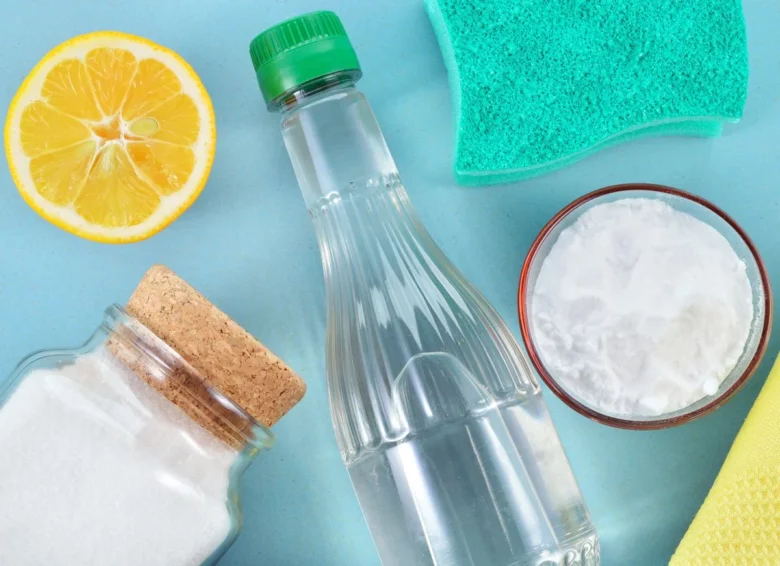Everyone wants a clean and germ-free bathroom, but many people are looking for cleaning products that don’t contain tonnes of chemicals. Making your own natural disinfectants is attractive because they are easy to use, inexpensive and good for the environment. This guide shows you how to create natural solutions to keep your bathroom clean and germ-free using items you probably already have in your kitchen.
The Charm of Natural Detergents:
Health and Environmental Benefits
When you use natural disinfectants, you are less likely to be exposed to strong chemicals that are harmful to your health and the environment. Chemical cleaning products often contain volatile organic compounds (VOCs), which can irritate the lungs, cause headaches and lead to other health problems. Natural disinfectants, on the other hand, are a safe way to clean and are just as effective without the risk of side effects.
Effective Use of Funds
Making your own disinfectant is a great way to save money. Many natural products have multiple uses and are inexpensive, so they are an inexpensive way to keep your bathroom clean. On the other hand, commercial cleaning products can be expensive, especially those that claim to be “green” or “natural.”
How Easy is It to Prepare?
One of the advantages of natural disinfectants is that they are very easy to make. With just a few easy-to-find items, you can create a powerful cleaning solution without much work. This ease of use makes you more likely to use it regularly and incorporate it into your cleaning routine.
Ingredients Needed for Natural Cleaners:
Apple Cider Vinegar
Because vinegar is acidic, it is a great natural way to clean and disinfect surfaces, killing bacteria and viruses. It is ideal for cleaning bathrooms as it removes grease and soap residue.
Baking Soda
Baking soda is a great way to remove odors and is gentle on surfaces. It fizzes when mixed with vinegar and helps remove stubborn stains and clean grout beautifully.
Essential Oils
Essential oils such as tea tree, lavender and lemon not only make your cleaning products smell wonderful, but they also kill bacteria. Tea tree oil is an oil known for killing bacteria, viruses and fungi.
Hydrogen Peroxide
Hydrogen peroxide works great in place of bleach. This cleaner is highly effective at killing bacteria, bleaching grout, and removing stains without the strong odor associated with bleach.
Castile Soap
Castile soap is plant-based and gentle, but still does the job. It can be mixed with liquid detergents to make it work better and remove dirt without leaving any waste.
How to Make Your Own Natural Bathroom Cleaner:
All-Purpose Cleaner for the Bathroom
In a spray bottle, mix 1 part water, 1 part vinegar and 10 to 15 drops of tea tree oil. Shake well before each use. This cleaner is ideal for cleaning sinks, tables and other surfaces.
Mold and Mildew Killers
Mix hydrogen peroxide and water in a spray bottle. Spray it on areas with mold or mildew, wait an hour, then scrub with a brush and rinse. If the mold is really bad, reapply the solution and let it sit overnight before wiping it off.
Toilet Bowl Cleaner
Make a mixture by combining 1/2 cup baking soda, 1/4 cup castile soap and 1 tablespoon hydrogen peroxide. Let the paste sit in the toilet bowl for 15 minutes. Then scrub with a toilet brush and flush.
Mirror and Glass Cleaner
Combine 2 cups of water, 1/4 cup of vinegar and 1 teaspoon of cornmeal in a spray bottle. Spray onto the glass, shake well to loosen the cornmeal and wipe clean with a microfiber cloth for a smooth finish.
Mopping the Floor
Combine 1 gallon of hot water, ½ cup of vinegar and 15 to 20 drops of your favorite essential oil in a bucket. Use this mixture to mop bathroom floors. This keeps them clean and smelling wonderful.
Benefits of Natural Bathroom Cleaners:
Inner Peace
Natural cleaning products are ideal for family homes because they are safe for children and pets. When used, the risk of aspiration hazards, chemical burns and accidental poisoning is reduced.
Effectiveness
Despite what some people think, natural chemicals can be very effective at cleaning surfaces. Substances such as hydrogen peroxide and vinegar can kill many different bacteria.
Aromatherapy
Adding essential oils to a homemade cleaner can make cleaning feel like aromatherapy. Not only will this make your bathroom smell wonderful, but it can also help improve your mood.
How to Make Homemade Disinfectants Work Better:
Correct Mixing Ratio
You must follow the recipe instructions carefully to ensure that your homemade disinfectant is effective. If the proportions are not correct, the treatments may not work because they are too weak, or they may be too strong and damage the surface.
Shelf Life and Storage
Keep your homemade disinfectant fresh by placing it in a clearly labelled, airtight container. Most natural cleansers last about a month, but this can vary depending on the ingredients.
Regular Cleaning Schedule
To keep things as clean and germ-free as possible, use natural disinfectants as part of your cleaning routine. Regular disinfection keeps your bathroom fresh between deep cleanings and prevents the growth of bacteria.
Conclusion:
If you want to protect the environment, save money and reduce your exposure to chemicals, making your own natural bathroom cleaner is a great idea. With just a few simple items and recipes, you can create natural cleaning products that will keep your bathroom sparkling and germ-free. Trust the power of natural cleaning products and enjoy a better, cleaner home.
FAQs:
1. Why are vinegar and baking soda great bathroom disinfectants?
Unique properties make vinegar and baking soda good natural disinfectants. The acetic acid in vinegar kills bacteria and viruses by breaking down their cell structures. It removes oil and soap residues very well. However, slightly alkaline baking soda can dissolve dirt and grease in water. Thanks to its abrasive nature, it can also be scrubbed. Baking soda mixed with vinegar works well to clean and remove bacteria from surfaces.
2. Can essential oils in DIY disinfectants kill bacteria or add fragrance?
Many essential oils contain antimicrobial properties that kill or inhibit bacteria, fungi and viruses. Its broad-spectrum antibacterial action makes tea tree oil useful in fighting a variety of infections. Lavender oil and lemon oil have antibacterial and antiviral properties. Although essential oils smell wonderful, they can help DIY disinfectants reduce the bacterial load on surfaces.
3. How often should I change my homemade toilet disinfectant to make it effective?
It’s a good idea to replace your homemade toilet disinfectant every month. Natural substances can deteriorate or lose their effectiveness when mixed with water. To keep your DIY disinfectant effective, make a small amount that you can use for a few weeks and store it in a cool place. Before use, stir the mixture to combine any separated ingredients.
4. Are there any risks associated with using hydrogen peroxide as a natural bathroom disinfectant?
Hydrogen peroxide can be safely disinfected if handled properly. However, excessive or prolonged contact with skin or substances may cause skin irritation or bleaching. Use diluted hydrogen peroxide and wear gloves when handling. Light will reduce its effectiveness, so store it in a dark container, out of direct sunlight. To avoid damage to the surface or fabric, test on a small, inconspicuous area first.
5. How should a natural toilet disinfectant be safely stored and labelled?
These tips can help you safely store and label your DIY natural toilet disinfectant:
- Store the solution in a clean, airtight container made of material that does not react with the contents, such as glass.
- Label each container with the contents, date of manufacture, and safety precautions (such as “keep out of reach of children”).
- If the disinfectant needs to be diluted, please include instructions for use.
- To maintain its effectiveness, keep the disinfectant cool, dry and out of direct sunlight.
- DIY disinfectants should not be used for food storage.

